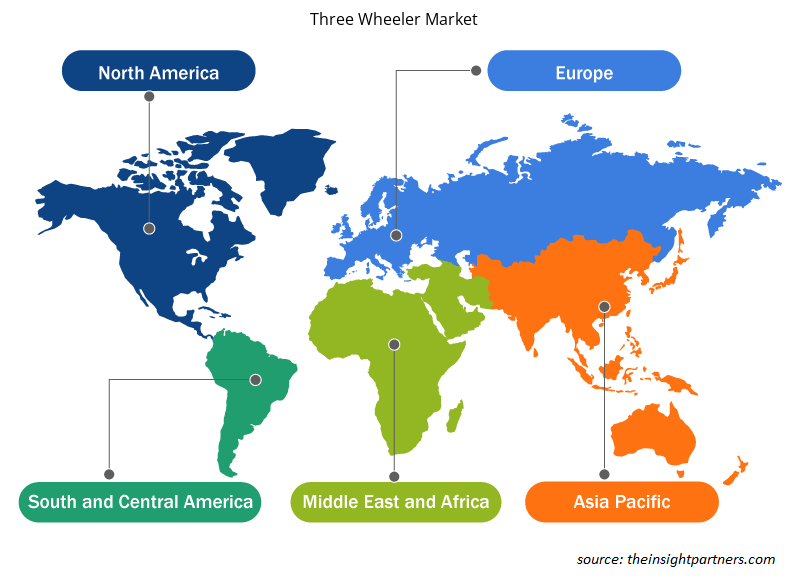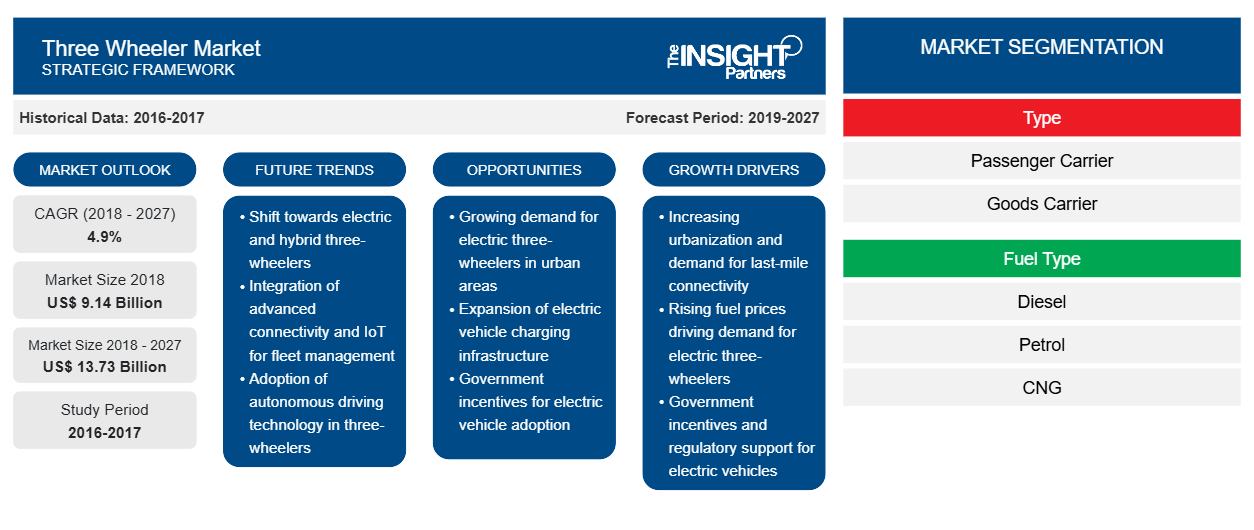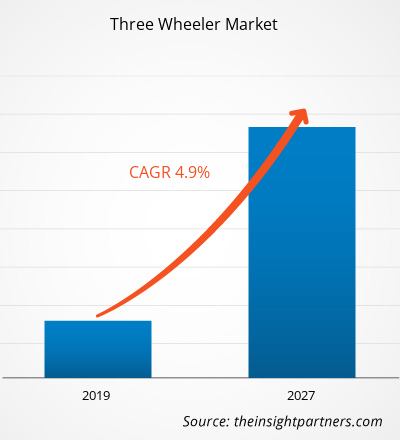Der Markt für Dreiräder hatte im Jahr 2018 einen Wert von 9,14 Milliarden US-Dollar und soll von 2019 bis 2027 mit einer durchschnittlichen jährlichen Wachstumsrate von 4,9 % wachsen und bis 2027 13,73 Milliarden US-Dollar erreichen .
Dreirädrige Personentransporter sind Dreiräder, die zum Transport von Passagieren verwendet werden. Dreirädrige Personentransporter bieten Platz für mindestens drei und höchstens fünf bis sechs Passagiere. In ländlichen Gebieten können je nach Bedarf mehr als sechs Passagiere mit dreirädrigen Personentransportern reisen. E-Rikschas sind eine der Hauptarten von Dreirädern . E-Rikschas werden mit Batterie betrieben und sind umweltfreundliche Fahrzeuge mit weniger Abgasen und Lärm als herkömmliche Dreiräder . E-Rikschas können fünf bis sechs Passagiere befördern. Die steigende Nachfrage nach elektrischen Dreirädern , das Bevölkerungswachstum und der steigende Bedarf an einem Fahrzeug, das bei Verkehrsstaus in der Region hilft, haben das Wachstum des globalen Marktes für Dreiräder gefördert . Im Prognosezeitraum 2018 nimmt die Region APAC eine herausragende Stellung auf dem Markt für Dreiräder ein . Länder wie Indien werden im Prognosezeitraum voraussichtlich das Inlands- und Exportgeschäftssegment dominieren. Darüber hinaus konzentrieren sich viele etablierte Unternehmen aus Indien auf die Herstellung von Dreirädern, die den BS (Bharat Stage) VI-Normen entsprechen, die bis 2020 eingeführt werden, um die Emissionen von Feinstaub, Stickoxiden und Schwefel unter Kontrolle zu halten. Ein signifikantes Wachstum ist in China zu beobachten, gefolgt von anderen asiatischen Ländern wie Thailand und Malaysia, aufgrund des steigenden Bedarfs an Transportmitteln für ländliche und halbstädtische Gebiete des Landes und der wachsenden Bevölkerung.
Passen Sie diesen Bericht Ihren Anforderungen an
Sie erhalten kostenlos individuelle Anpassungen an jedem Bericht, einschließlich Teilen dieses Berichts oder einer Analyse auf Länderebene, eines Excel-Datenpakets sowie tolle Angebote und Rabatte für Start-ups und Universitäten.
- Holen Sie sich die wichtigsten Markttrends aus diesem Bericht.Dieses KOSTENLOSE Beispiel umfasst eine Datenanalyse von Markttrends bis hin zu Schätzungen und Prognosen.
Markteinblicke
Die steigende Nachfrage nach umweltfreundlichen Dreirädern treibt das Wachstum des Marktes voran
Die Automobilindustrie weltweit erlebt einen ständigen Anstieg der Zahl neuer Dreiradhersteller. Die Dreiradhersteller beobachten kontinuierlich die Entwicklung des Segments der elektrischen Dreiräder, da dieser Bereich weltweit das Interesse der Kunden weckt. Die globale Automobilindustrie erlebt einen deutlichen Wandel von traditionellen Dreirädern zu elektrischen Dreirädern .
Regierungen verschiedener Länder ergreifen die Initiative zur Einführung von elektrischen Dreirädern . So startete das indische Ministerium für Schwerindustrie und öffentliche Unternehmen im März 2018 Phase II des FAME-Programms Indien, das am 1. April 2019 für die nächsten drei Jahre mit einem Gesamtbudget von 1,39 Milliarden US-Dollar gestartet wurde. Diese Phase soll vor allem die Elektrifizierung des öffentlichen Nahverkehrs und des Personennahverkehrs unterstützen und soll durch Subventionen 7.000 E-Busse, 500.000 E - Dreiräder , 55.000 E-Vierrad-Pkw und 100.000 E - Zweiräder unterstützen . Ziel dieser Phase des FAME-Programms ist die Einrichtung einer angemessenen öffentlichen Ladeinfrastruktur, um das Vertrauen der Nutzer von Elektrofahrzeugen zu stärken . Dabei hofft das Ministerium für Schwerindustrie und öffentliche Unternehmen auf die Einbindung und aktive Teilnahme verschiedener Interessengruppen, darunter Industrie und öffentliche Unternehmen ( PSEs ) sowie Regierungsbehörden. Die wichtigsten Akteure auf dem Markt streben die Entwicklung von Elektrofahrzeugen an. So brachte beispielsweise der italienische Automobilhersteller Piaggio & C. SpA den Piaggio Ape E-City aus seiner Reihe der elektrischen Dreiräder Piaggio Ape Electrik auf den Markt. Das E-Auto ist mit einem austauschbaren Lithium-Ionen-Akku ausgestattet und kann mit einer Aufladung eine Reichweite von etwa 70-80 km zurücklegen. Darüber hinaus kündigte Euler Motors im August 2019 an, Anfang 2020 elektrische leichte Nutzfahrzeuge mit drei Rädern in Indien auf den Markt zu bringen.
Geografisch gesehen sind Indien und China die Heimat zahlreicher Hersteller von Dreirädern, und die Akzeptanz von elektrischen Dreirädern steigt von Jahr zu Jahr rasant an. Neben Indien und China entwickeln sich auch Länder in Südamerika, wie Brasilien, Argentinien, und der Nahe Osten und afrikanische Länder wie Südafrika, Nigeria und Ägypten, hinsichtlich der Akzeptanz von elektrischen Dreirädern in der Automobilindustrie rasant. Der asiatisch-pazifische Raum dominiert und erlebt ein enormes Wachstum in der Automobilindustrie. Dennoch benötigen die in der Region tätigen Automobilunternehmen eine verbesserte Anzahl von Partnerschaften mit Komponentenanbietern, um die Einführung von elektrischen Dreirädern exponentiell zu steigern. Strategische Partnerschaften, Zusammenarbeit, Verträge und Akquisitionen mit anderen Marktteilnehmern sind der Hauptfaktor für die Branchenakteure, um ihre Märkte voranzutreiben, was den Dreiradmarkt in den kommenden Jahren voraussichtlich weltweit vorantreiben wird.
Typ-Einblicke
Im Typensegment haben Personentransporter den größten Anteil am weltweiten Markt für Dreiräder. Personentransporter sind die günstigsten Transportfahrzeuge, die sich verschiedene private Transportunternehmen und Einzelpersonen leisten können, die ihr Einkommen aus Transportjobs beziehen. Das Wachstum dieses Segments wird durch die steigende Nachfrage nach kostengünstigen Personentransportern vorangetrieben, beispielsweise aufgrund fehlender geeigneter Straßen. Dreiräder sind hauptsächlich auf unzureichende Transportmöglichkeiten und städtische Gebiete mit starkem Verkehrsaufkommen zurückzuführen.
Erkenntnisse zum Kraftstofftyp
Der Markt für Dreiräder ist nach Kraftstoffart in Diesel, Benzin, CNG, LPG und Elektro unterteilt. Das Benzinsegment eroberte den dominierenden Anteil am globalen Markt für Dreiräder.
Marktinitiativen sind Strategien, mit denen Unternehmen ihre Präsenz weltweit ausweiten und die wachsende Kundennachfrage befriedigen möchten. Die Marktteilnehmer auf dem Markt für Dreiräder konzentrieren sich hauptsächlich auf Produkt- und Serviceverbesserungen durch die Integration fortschrittlicher Funktionen und Technologien. Durch den Abschluss von Partnerschaften, Verträgen, Joint Ventures und die Eröffnung neuer Niederlassungen auf der ganzen Welt versuchen Unternehmen, ihren Marktanteil und ihre Markenpräsenz zu erhöhen. Die meisten Marktinitiativen wurden im asiatisch-pazifischen Raum beobachtet, der ein hohes Potenzial für zukünftiges Marktwachstum bietet. Einige davon sind unten aufgeführt:
2019: Im Dezember 2019 gab Greaves Cotton eine Partnerschaft mit der TVS Motor Company bekannt. Im Rahmen dieser Partnerschaft würde Greaves Cotton als autorisiertes Servicecenter für die Dreiräder von TVS Motor in Indien fungieren.
2018: ATUL Auto Limited ging eine Partnerschaft mit JBM Industries ein, einem in Indien ansässigen Autoteileunternehmen. Das Unternehmen hat sich zusammengeschlossen, um sein Geschäft mit dreirädrigen Elektroautos auszubauen.
Regionale Einblicke in den Dreiradmarkt
Die regionalen Trends und Faktoren, die den Markt für Dreiräder im Prognosezeitraum beeinflussen, wurden von den Analysten von Insight Partners ausführlich erläutert. In diesem Abschnitt werden auch Marktsegmente und Geografie für Dreiräder in Nordamerika, Europa, im asiatisch-pazifischen Raum, im Nahen Osten und Afrika sowie in Süd- und Mittelamerika erörtert.

- Erhalten Sie regionale Daten zum Markt für Dreiräder
Umfang des Marktberichts für Dreiräder
| Berichtsattribut | Details |
|---|---|
| Marktgröße im Jahr 2018 | 9,14 Milliarden US-Dollar |
| Marktgröße bis 2027 | 13,73 Milliarden US-Dollar |
| Globale CAGR (2018 - 2027) | 4,9 % |
| Historische Daten | 2016-2017 |
| Prognosezeitraum | 2019–2027 |
| Abgedeckte Segmente | Nach Typ
|
| Abgedeckte Regionen und Länder | Nordamerika
|
| Marktführer und wichtige Unternehmensprofile |
|
Marktteilnehmerdichte: Der Einfluss auf die Geschäftsdynamik
Der Markt für Dreiradfahrzeuge wächst rasant, angetrieben durch die steigende Nachfrage der Endnutzer aufgrund von Faktoren wie sich entwickelnden Verbraucherpräferenzen, technologischen Fortschritten und einem größeren Bewusstsein für die Vorteile des Produkts. Mit steigender Nachfrage erweitern Unternehmen ihr Angebot, entwickeln Innovationen, um die Bedürfnisse der Verbraucher zu erfüllen, und nutzen neue Trends, was das Marktwachstum weiter ankurbelt.
Die Marktteilnehmerdichte bezieht sich auf die Verteilung von Firmen oder Unternehmen, die in einem bestimmten Markt oder einer bestimmten Branche tätig sind. Sie gibt an, wie viele Wettbewerber (Marktteilnehmer) in einem bestimmten Marktraum im Verhältnis zu seiner Größe oder seinem gesamten Marktwert präsent sind.
Die wichtigsten auf dem Dreiradmarkt tätigen Unternehmen sind:
- ATUL Auto Limited
- Piaggio & C. SpA
- Bajaj Auto Ltd
- JS AUTO (P) LTD.
- Speego Vehicles Co Pvt Limited
Haftungsausschluss : Die oben aufgeführten Unternehmen sind nicht in einer bestimmten Reihenfolge aufgeführt.

- Überblick über die wichtigsten Akteure auf dem Markt für Dreiräder
Dreiradmarkt – nach Typ
- Passagiertransporter
- Gütertransporteur
Dreiradmarkt – nach Kraftstoffart
- Diesel
- Benzin
- Erdgas
- Flüssiggas
- Elektrisch
Globaler Dreiradmarkt nach Regionen
Nordamerika
- UNS
- Kanada
- Mexiko
Europa
- Frankreich
- Deutschland
- Italien
- Vereinigtes Königreich
- Russland
- Restliches Europa
Asien-Pazifik
- China
- Indien
- Südkorea
- Japan
- Australien
- Restlicher Asien-Pazifik-Raum
Rest der Welt
- Afrika
- Lateinamerika
Firmenprofile
- ATUL Auto Limited
- Bajaj Auto Ltd.
- JS AUTO (P) LTD.
- Mahindra & Mahindra Ltd.
- Piaggio & C. SpA
- Scooters India Limited
- Speego Vehicles Co Pvt Limited
- Terra Motors Corporation
- TVS Motor Company
- Xianghe Qiangsheng Elektro-Dreiradfabrik
- Historische Analyse (2 Jahre), Basisjahr, Prognose (7 Jahre) mit CAGR
- PEST- und SWOT-Analyse
- Marktgröße Wert/Volumen – Global, Regional, Land
- Branche und Wettbewerbsumfeld
- Excel-Datensatz



Report Coverage
Revenue forecast, Company Analysis, Industry landscape, Growth factors, and Trends

Segment Covered
This text is related
to segments covered.

Regional Scope
North America, Europe, Asia Pacific, Middle East & Africa, South & Central America

Country Scope
This text is related
to country scope.
Häufig gestellte Fragen
The three-wheeler passenger carrier segment dominates the global three-wheeler market as it is one of the cheapest transport vehicles that can be afforded by various private transport operators and by individuals whose earning is from transport jobs. Asian countries like Bangladesh, Sri Lanka, and Nepal and African countries like Ghana, Nigeria, Tanzania, and Kenya accounted for more than 90% of the exports in the Indian three-wheeler PC market. During 2018, the ICE-powered three-wheelers segment accounted for the significant shares and dominated the three-wheel passenger carrier market due to the increased usage of diesel, gasoline, bio-diesel, and compressed natural gas/liquefied petroleum gas (CNG/LPG) to power the engine in developing nations. In Asia-Pacific, India is the major contributor to the three-wheeler passenger carrier market
The key players in the market are focusing on investing in the production of three wheelers in African and South American countries. There have been prominent strategies made in recent years by automakers to increase the usage of three wheelers in these regions. For instance, in August 2016, Lohia Auto Industries entered Africa with three wheeler operated on diesel. A reduction in organized public transport systems has led to rapid growth in non-conventional means of public transport, initially provided by minibuses and shared taxi/vans, and more recently by commercial three-wheelers. Unlike cities in South and East Asia, ownership and use of motorized and electric three-wheelers as a personalized vehicle is extremely small in sub-Saharan cities
The massive populations of China and India and the mounting middle-class population in these countries, as well as booming automotive sector scenarios in both countries, are anticipated to have a bright future for the adoption of three-wheeler vehicles. These countries are the hub for various local automakers, which are focusing on the development of a three-wheeler vehicle, most commonly known as auto-rickshaw/ tuk-tuk. Furthermore, China is the largest producer of passenger cars across the globe; also, India, Japan, and South Korea are some of the primary vehicle manufacturing countries. The continuous economic growth in developed and developing countries such as India and China, coupled with the presence of a high number of manufacturers in countries such as China and Japan, has facilitated the rapid growth of the automotive industry in this region
Trends and growth analysis reports related to Automotive and Transportation : READ MORE..
The List of Companies - Three Wheeler Market
- ATUL Auto Limited
- Piaggio & C. SpA
- Bajaj Auto Ltd
- J.S. AUTO (P) LTD.
- Speego Vehicles Co Pvt Limited
- Mahindra & Mahindra Ltd.
- Scooters India Limited
- TVS Motor Company
- Terra Motors Corporation
- Xianghe Qiangsheng Electric Tricycle Factory
The Insight Partners performs research in 4 major stages: Data Collection & Secondary Research, Primary Research, Data Analysis and Data Triangulation & Final Review.
- Data Collection and Secondary Research:
As a market research and consulting firm operating from a decade, we have published and advised several client across the globe. First step for any study will start with an assessment of currently available data and insights from existing reports. Further, historical and current market information is collected from Investor Presentations, Annual Reports, SEC Filings, etc., and other information related to company’s performance and market positioning are gathered from Paid Databases (Factiva, Hoovers, and Reuters) and various other publications available in public domain.
Several associations trade associates, technical forums, institutes, societies and organization are accessed to gain technical as well as market related insights through their publications such as research papers, blogs and press releases related to the studies are referred to get cues about the market. Further, white papers, journals, magazines, and other news articles published in last 3 years are scrutinized and analyzed to understand the current market trends.
- Primary Research:
The primarily interview analysis comprise of data obtained from industry participants interview and answers to survey questions gathered by in-house primary team.
For primary research, interviews are conducted with industry experts/CEOs/Marketing Managers/VPs/Subject Matter Experts from both demand and supply side to get a 360-degree view of the market. The primary team conducts several interviews based on the complexity of the markets to understand the various market trends and dynamics which makes research more credible and precise.
A typical research interview fulfils the following functions:
- Provides first-hand information on the market size, market trends, growth trends, competitive landscape, and outlook
- Validates and strengthens in-house secondary research findings
- Develops the analysis team’s expertise and market understanding
Primary research involves email interactions and telephone interviews for each market, category, segment, and sub-segment across geographies. The participants who typically take part in such a process include, but are not limited to:
- Industry participants: VPs, business development managers, market intelligence managers and national sales managers
- Outside experts: Valuation experts, research analysts and key opinion leaders specializing in the electronics and semiconductor industry.
Below is the breakup of our primary respondents by company, designation, and region:

Once we receive the confirmation from primary research sources or primary respondents, we finalize the base year market estimation and forecast the data as per the macroeconomic and microeconomic factors assessed during data collection.
- Data Analysis:
Once data is validated through both secondary as well as primary respondents, we finalize the market estimations by hypothesis formulation and factor analysis at regional and country level.
- Macro-Economic Factor Analysis:
We analyse macroeconomic indicators such the gross domestic product (GDP), increase in the demand for goods and services across industries, technological advancement, regional economic growth, governmental policies, the influence of COVID-19, PEST analysis, and other aspects. This analysis aids in setting benchmarks for various nations/regions and approximating market splits. Additionally, the general trend of the aforementioned components aid in determining the market's development possibilities.
- Country Level Data:
Various factors that are especially aligned to the country are taken into account to determine the market size for a certain area and country, including the presence of vendors, such as headquarters and offices, the country's GDP, demand patterns, and industry growth. To comprehend the market dynamics for the nation, a number of growth variables, inhibitors, application areas, and current market trends are researched. The aforementioned elements aid in determining the country's overall market's growth potential.
- Company Profile:
The “Table of Contents” is formulated by listing and analyzing more than 25 - 30 companies operating in the market ecosystem across geographies. However, we profile only 10 companies as a standard practice in our syndicate reports. These 10 companies comprise leading, emerging, and regional players. Nonetheless, our analysis is not restricted to the 10 listed companies, we also analyze other companies present in the market to develop a holistic view and understand the prevailing trends. The “Company Profiles” section in the report covers key facts, business description, products & services, financial information, SWOT analysis, and key developments. The financial information presented is extracted from the annual reports and official documents of the publicly listed companies. Upon collecting the information for the sections of respective companies, we verify them via various primary sources and then compile the data in respective company profiles. The company level information helps us in deriving the base number as well as in forecasting the market size.
- Developing Base Number:
Aggregation of sales statistics (2020-2022) and macro-economic factor, and other secondary and primary research insights are utilized to arrive at base number and related market shares for 2022. The data gaps are identified in this step and relevant market data is analyzed, collected from paid primary interviews or databases. On finalizing the base year market size, forecasts are developed on the basis of macro-economic, industry and market growth factors and company level analysis.
- Data Triangulation and Final Review:
The market findings and base year market size calculations are validated from supply as well as demand side. Demand side validations are based on macro-economic factor analysis and benchmarks for respective regions and countries. In case of supply side validations, revenues of major companies are estimated (in case not available) based on industry benchmark, approximate number of employees, product portfolio, and primary interviews revenues are gathered. Further revenue from target product/service segment is assessed to avoid overshooting of market statistics. In case of heavy deviations between supply and demand side values, all thes steps are repeated to achieve synchronization.
We follow an iterative model, wherein we share our research findings with Subject Matter Experts (SME’s) and Key Opinion Leaders (KOLs) until consensus view of the market is not formulated – this model negates any drastic deviation in the opinions of experts. Only validated and universally acceptable research findings are quoted in our reports.
We have important check points that we use to validate our research findings – which we call – data triangulation, where we validate the information, we generate from secondary sources with primary interviews and then we re-validate with our internal data bases and Subject matter experts. This comprehensive model enables us to deliver high quality, reliable data in shortest possible time.


 Holen Sie sich ein kostenloses Muster für diesen Bericht
Holen Sie sich ein kostenloses Muster für diesen Bericht